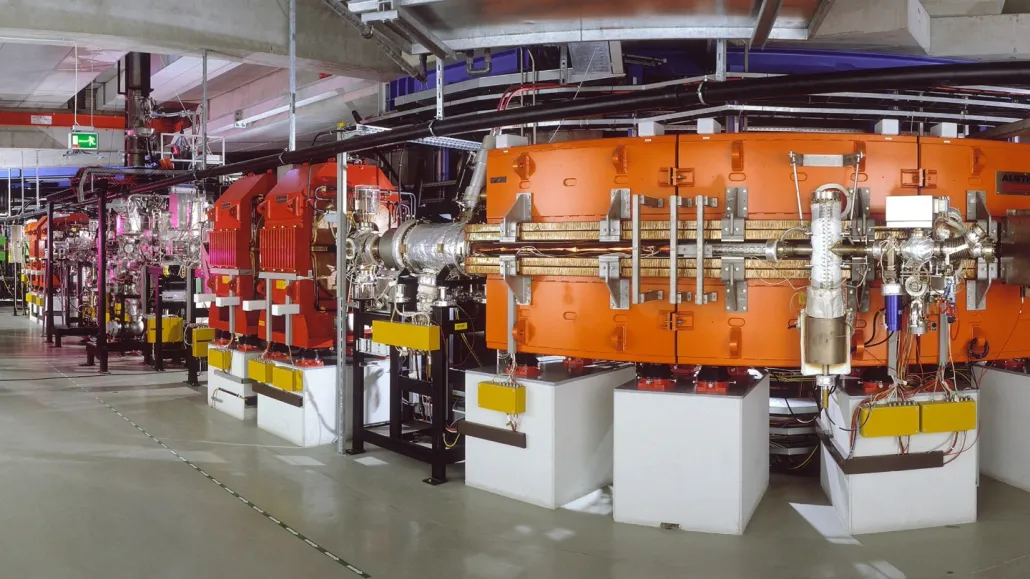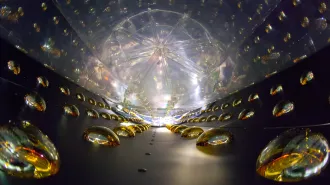
To test the theory of quantum electrodynamics in strong electromagnetic fields, scientists used highly charged uranium ions created at the GSI Helmholtz Centre in Darmstadt, Germany, and contained in the facility's experimental storage ring (shown).
J. Mai/GSI Helmholtzzentrum für Schwerionenforschung GmbH
To put one of physicists’ most important theories to the test, scientists go to extremes. Extremely strong electromagnetic fields, that is.
The theory of quantum electrodynamics, which describes interactions of electrically charged particles and light, has been checked to painstaking precision (SN: 2/23/23). The theory correctly predicts properties of simple atoms, like hydrogen or helium. But it’s less carefully tested under intense electromagnetic fields, like those that exist around large atomic nuclei.
The theory’s predictions hold up even in those conditions, physicist Robert Lötzsch and colleagues report in the Jan. 25 Nature.
Quantum electrodynamics, or QED, looms large in physics. It’s an integral part of the standard model of particle physics, the theory of fundamental particles and their interactions. So testing it in all possible scenarios is key.
To probe QED’s prowess, Lötzsch and colleagues turned to uranium, which has a whopping 92 protons in its nucleus. That nucleus has a correspondingly mighty electric field, almost a million times that of a hydrogen nucleus, and much stronger than any field that can be produced by humankind. The tests used uranium that had been stripped of all but two of its normal swarm of 92 electrons to form an ion, or electrically charged atom. This uranium ion is termed “helium-like uranium,” because helium atoms normally have just two electrons.
Lötzsch and colleagues ran their experiments at the GSI Helmholtz Centre for Heavy Ion Research in Darmstadt, Germany, accelerating uranium ions and sending them through a copper foil that peeled off all but one electron from each ion. When sent through nitrogen gas, the ions grabbed another electron to make helium-like uranium: a uranium nucleus with two electrons bound to it. This process left each uranium ion with one of its two electrons in a high-energy state. Those electrons quickly cascaded down in energy, through a sequence of jumps between energy levels. By measuring X-rays released from a particular jump, the researchers determined the energy of that transition.
The measured energy matched predictions based on QED — the theory held up.
In strong electromagnetic fields, “how QED has to be calculated completely changes from how it’s done in low fields,” says Lötzsch, of Friedrich Schiller University Jena in Germany. In general, QED calculations must consider the electrons’ interactions with “virtual” particles, which continually flit into and out of existence, according to quantum physics. That includes not only single interactions of this sort, but also two (or more) interactions. In strong electromagnetic fields around atomic nuclei, calculating the effect of two interactions becomes more complex. The electric field, rather than slightly tweaking the calculation as it does for hydrogen or helium, dramatically changes it. What’s more, in the case of helium-like uranium, the interactions of the two electrons must also be calculated.
Highly charged ions are “ideal mini laboratories that allow us to study the behavior of bound electrons in the extremely strong fields,” says theoretical physicist Aleksei Malyshev of St. Petersburg University in Russia, who was not involved with the research. That makes for an experiment that “is sensitive to the most sophisticated higher-order QED effects.”
Many physicists expect that another theory will eventually supplant the standard model, and a flaw in QED’s predictions could point the way. The new result is “a very unique and stringent test of the QED theory,” says physicist Fabian Heiße of the Max Planck Institute for Nuclear Physics in Heidelberg, Germany, who was not involved with the research. “Such tests are very important for the search of physics beyond the standard model.”







